The Application Virtualization Market is estimated to be valued at USD 5.4 billion in 2025 and is projected to reach USD 18.3 billion by 2035, registering a compound annual growth rate (CAGR) of 12.9% over the forecast period.
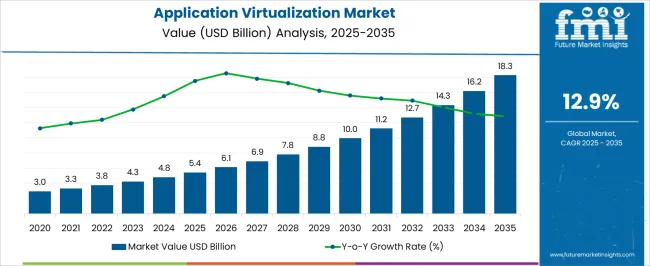
| Metric | Value |
|---|---|
| Application Virtualization Market Estimated Value in (2025 E) | USD 5.4 billion |
| Application Virtualization Market Forecast Value in (2035 F) | USD 18.3 billion |
| Forecast CAGR (2025 to 2035) | 12.9% |
The application virtualization market is expanding at a steady pace as organizations increasingly prioritize cost efficiency, scalability, and security in their IT infrastructure. Rising demand for seamless application access across multiple devices and remote work environments is strengthening adoption.
Enterprises are embracing virtualization to reduce dependency on traditional hardware, streamline software updates, and enhance application lifecycle management. Advancements in cloud technology and stronger focus on data protection are further driving deployment across industries.
Additionally, regulatory compliance requirements and enterprise digitization strategies are encouraging investment in virtualization platforms that provide centralized control and reduced operational risks. The overall outlook remains positive, with continuous integration of AI and automation expected to enhance performance, reduce latency, and optimize enterprise IT resource utilization.
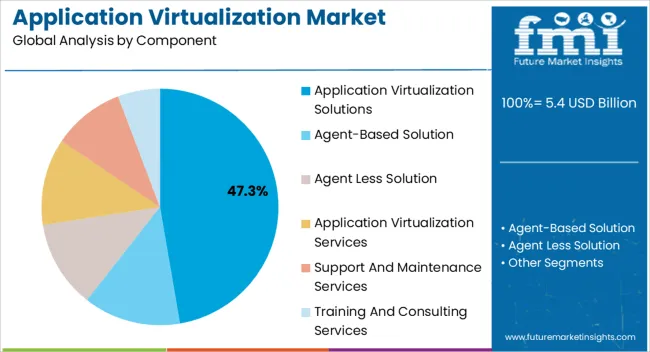
The application virtualization solutions segment is expected to hold 47.30% of the total revenue by 2025 within the component category, positioning it as the leading segment. This growth is being driven by the ability of virtualization solutions to simplify application management, reduce software conflicts, and ensure compatibility across diverse operating systems.
Enterprises are increasingly valuing centralized control and streamlined deployment offered by these solutions, particularly as they expand remote and hybrid work models. The demand for reducing downtime, improving scalability, and enhancing security has further supported adoption.
As businesses continue to modernize IT infrastructure, the solutions segment is set to maintain its leadership position through widespread implementation.
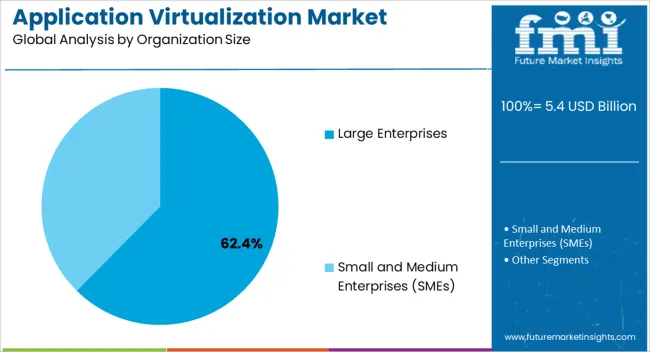
The large enterprises segment is expected to account for 62.40% of the total market revenue by 2025 under the organization size category, making it the dominant segment. This growth is driven by the ability of large organizations to invest in advanced virtualization solutions, integrate hybrid cloud strategies, and manage complex IT infrastructures.
The need to optimize resource utilization, ensure application security, and enable seamless workforce collaboration has further accelerated adoption. Large enterprises also benefit from economies of scale, which support implementation of robust virtualization strategies across diverse departments and geographies.
Consequently, the large enterprises segment continues to dominate as it leverages scale, resources, and long term digital transformation roadmaps to maximize the benefits of application virtualization.
As per the earlier published reports on application virtualization technologies, the net worth of its market in 2020 stood at USD 2,533.1 million. Following the year 2020, the demand for application virtualization solutions and services grew at an average of 10.8% until the year 2025.
During the pandemic years, many businesses adopted a work-from-home model and needed a highly secure platform to host their apps on internal clouds. So by capitalizing on this rare opportunity, the overall market valuation was figured out to have reached USD 3,824.7 million by 2025 end.
Some key trends in the market include the higher adoption of cloud-based technologies or services as a computing platform due to technical enhancements & growing trend of using high-tech technologies.
Several benefits are provided by application virtualization such as installation. It is only on one centralized computer instead of installing on every computer and easy up-gradation expect a boost to the market in the forthcoming years.
The availability of the application without installing it and easy control of the application by admins to allow or deny access to the application to a particular user is predicted to propel the market growth.
It has been observed that developing countries such as China and India are focusing more on implementing new technologies. There is an increase in the implementation of third-party platforms by businesses for the implementation of applications. This is one of the key trends that is anticipated to favor the growth of the market during the forecast period.
The solution component is further sub-segmented into the following: agent-based solution and agentless solution. The services component is further sub-segmented into the following: support and maintenance services and training and consulting services.
According to the FMI, the application virtualization market by component for a solution is expected to thrive at a CAGR of 13.1% during the forecast period. The implementation of application virtualization solutions may help organizations strengthen their operation policies, thus saving cost and time. Moreover, it is providing a great value proposition for organizations, as well as their clients in the long run.
The adoption of application virtualization is surging day by day and more often across small and medium enterprises or sectors. So the industry players are witnessing a rise in the need for application virtualization services including maintenance, consulting, and training. Also, many leading players offering application virtualization now consider having a dedicated support staff to support their clients as a strategic investment.
| Category | By Component Type |
|---|---|
| Top Segment | Agent-based Solution |
| Market Share in Percentage | 39.2% |
| Category | By Deployment Type |
|---|---|
| Top Segment | Public-cloud |
| Market Share in Percentage | 56.3% |
The private cloud category of the market by deployment type is expected to grow at a CAGR of 12.4% during the forecast period. Owing to the higher adoption of cloud-based technologies or services as a computing platform. Due to technical enhancements & growing trend of using high-tech technologies.
On the basis of organization size, the market can be segmented into the following: large enterprises and SMEs. Based on end-user verticals, the market can be segmented into the following: BFSI, healthcare, IT and telecom, government and defense, construction, education, and others.
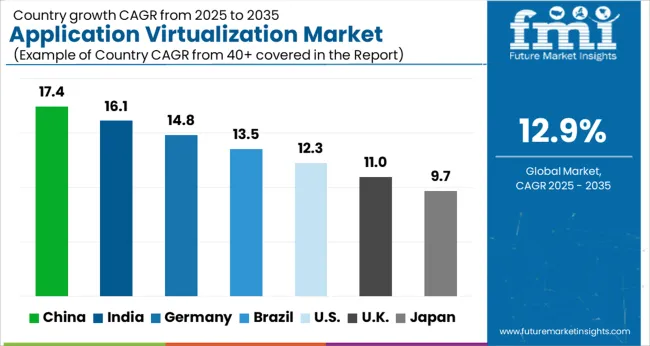
| Regional Market Comparison | Global Market Share in Percentage |
|---|---|
| North America | 28.3% |
| Europe | 23.4% |
The North American region dominates the global application virtualization market. Attributed to the presence of leading IT players in the region. In addition to that, growth in small and medium enterprises (SMEs) in the United States and Canada has led to a surge in the market.
In North America, the United States is the most mature market in terms of the adoption of application virtualization solutions due to various factors. Such as regulatory standards, advanced IT infrastructure, as well as the presence of sizable enterprises, and the availability of technical expertise in the country.
| Regional Market Comparison | Global Market Share in Percentage |
|---|---|
| United States | 20.2% |
| Germany | 9.6% |
| Japan | 7.1% |
| Australia | 3.2% |
In 2025, the sales of application virtualization software in the United States reached a valuation of USD 18.3 billion and by 2035, it could progress with a CAGR of 12.9%. China is expected to reach a market size of USD 950 million by 2035, representing a CAGR of 14.2%, over the forecast period.
Japan and the United Kingdom are expected to reach a market size of USD 770 million and USD 560 million by 2035. Representing growth forecasts of 11.4% and 12.1% respectively, throughout the forecast period. On the other hand, South Korea is expected to reach a market size of USD 480 million by 2035, representing a CAGR of 10.6%, during the forecast period.
| Regional Markets | CAGR (2025 to 2035) |
|---|---|
| United Kingdom | 12.5% |
| China | 14.2% |
| India | 13.6% |
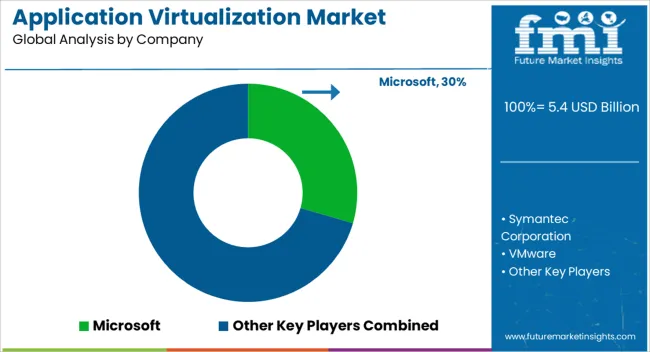
With a sizable application virtualization market share, these main firms are concentrating on growing their consumer base in new countries. These businesses are making use of strategic collaboration initiatives to grow their market share and profits.
Mid-size and smaller businesses, on the other hand, are expanding their market presence by gaining new contracts and entering new markets, thanks to technical developments and product innovations.
Recent Developments by the Application Virtualization Service Providers
The global application virtualization market is estimated to be valued at USD 5.4 billion in 2025.
The market size for the application virtualization market is projected to reach USD 18.3 billion by 2035.
The application virtualization market is expected to grow at a 12.9% CAGR between 2025 and 2035.
The key product types in application virtualization market are application virtualization solutions, agent-based solution, agent less solution, application virtualization services, support and maintenance services and training and consulting services.
In terms of deployment type, public cloud segment to command 55.8% share in the application virtualization market in 2025.






Our Research Products

The "Full Research Suite" delivers actionable market intel, deep dives on markets or technologies, so clients act faster, cut risk, and unlock growth.

The Leaderboard benchmarks and ranks top vendors, classifying them as Established Leaders, Leading Challengers, or Disruptors & Challengers.

Locates where complements amplify value and substitutes erode it, forecasting net impact by horizon

We deliver granular, decision-grade intel: market sizing, 5-year forecasts, pricing, adoption, usage, revenue, and operational KPIs—plus competitor tracking, regulation, and value chains—across 60 countries broadly.

Spot the shifts before they hit your P&L. We track inflection points, adoption curves, pricing moves, and ecosystem plays to show where demand is heading, why it is changing, and what to do next across high-growth markets and disruptive tech

Real-time reads of user behavior. We track shifting priorities, perceptions of today’s and next-gen services, and provider experience, then pace how fast tech moves from trial to adoption, blending buyer, consumer, and channel inputs with social signals (#WhySwitch, #UX).

Partner with our analyst team to build a custom report designed around your business priorities. From analysing market trends to assessing competitors or crafting bespoke datasets, we tailor insights to your needs.
Supplier Intelligence
Discovery & Profiling
Capacity & Footprint
Performance & Risk
Compliance & Governance
Commercial Readiness
Who Supplies Whom
Scorecards & Shortlists
Playbooks & Docs
Category Intelligence
Definition & Scope
Demand & Use Cases
Cost Drivers
Market Structure
Supply Chain Map
Trade & Policy
Operating Norms
Deliverables
Buyer Intelligence
Account Basics
Spend & Scope
Procurement Model
Vendor Requirements
Terms & Policies
Entry Strategy
Pain Points & Triggers
Outputs
Pricing Analysis
Benchmarks
Trends
Should-Cost
Indexation
Landed Cost
Commercial Terms
Deliverables
Brand Analysis
Positioning & Value Prop
Share & Presence
Customer Evidence
Go-to-Market
Digital & Reputation
Compliance & Trust
KPIs & Gaps
Outputs
Full Research Suite comprises of:
Market outlook & trends analysis
Interviews & case studies
Strategic recommendations
Vendor profiles & capabilities analysis
5-year forecasts
8 regions and 60+ country-level data splits
Market segment data splits
12 months of continuous data updates
DELIVERED AS:
PDF EXCEL ONLINE
Application Crowdtesting Service Market Size and Share Forecast Outlook 2025 to 2035
Application Integration Market Size and Share Forecast Outlook 2025 to 2035
Application Programming Interface (API) Security Market Size and Share Forecast Outlook 2025 to 2035
Application Development and Modernization (ADM) Market Size and Share Forecast Outlook 2025 to 2035
Application Release Automation Market Size and Share Forecast Outlook 2025 to 2035
Application Delivery Controllers Market Size and Share Forecast Outlook 2025 to 2035
Application Specific Integrated Circuit Market Size and Share Forecast Outlook 2025 to 2035
Application Processor Market Size and Share Forecast Outlook 2025 to 2035
Application Delivery Network Market by Product, End-user, Environment, Deployment Type, Vertical, and Region, Forecast through 2035
Application Control Software Market Insights – Growth & Forecast 2025-2035
Application Metrics and Monitoring Tools Market Analysis By Component, Mode, Deployment, Verticals, and Region through 2035
Virtualization Security Market Growth – Trends & Forecast 2023-2033
Virtualization Security Tools Market
Application Centric Infrastructure Market
Application Management Services Market Analysis – Trends & Forecast 2017-2027
IoT Application Enablement Market Size and Share Forecast Outlook 2025 to 2035
IoT Application Development Services Market Size and Share Forecast Outlook 2025 to 2035
MES Applications For Process Manufacturing Market Size and Share Forecast Outlook 2025 to 2035
CRM Application Software Market Report – Forecast 2017-2022
Data Virtualization Cloud Market Analysis – Growth & Forecast 2025 to 2035

Thank you!
You will receive an email from our Business Development Manager. Please be sure to check your SPAM/JUNK folder too.
Chat With
MaRIA